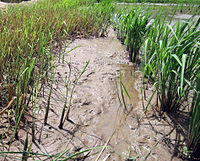
Photo from wikipedia
As a wild ancestor of cultivated rice, Oryza rufipogon is domesticated into cultivated rice Oryza sativa, many agricultural traits are newly created or disappear. In particular, in wild rice, awn… Click to show full abstract
As a wild ancestor of cultivated rice, Oryza rufipogon is domesticated into cultivated rice Oryza sativa, many agricultural traits are newly created or disappear. In particular, in wild rice, awn protects from predators and is easily blown by the wind and used as a means of propagation. However, awns gradually disappeared as they were breeding from wild rice to cultivated rice. Since awn development is disadvantageous to rice yield, it is important to understand the genetic basis related to awn development. In addition, characterization of the genes associated with awn development is helpful in analyzing the genetic relationships of rice from ancient times to the present for the regulatory mechanisms of awn formation. QTL analysis identified RM14330-RM218 on chromosome 3 using a 120 Cheongcheong/Nagdong double haploid population. Through screening of genes related to awn development in RM-14330-RM218, it is indicated that OsDRPq3 is a causal gene that can be involved in awn development. OsDRPq3 transcription level is maintained high in long awn and less yield populations during the panicle formation stage, the period during awn development. Moreover, the sequence of OsDRPq3 has high homology with the drooping protein leaf. This study provides a new resource for phylogenetic research of rice and exploration of awn development.
Journal Title: Plants
Year Published: 2022
Link to full text (if available)
Share on Social Media: Sign Up to like & get
recommendations!